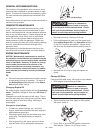
14 — ENG
MGP-670070
RECEPTACLES
Your generator is equipped with:
• one 120 volt GFCI duplex receptacle protected by
a 15 amp circuit breaker
• one 120 volt 3-prong twistlock receptacle pro-
tected by a 30 amp circuit breakers
• one 240 volt 4-prong twistlock receptacle pro-
tected by two 30 amp circuit breakers
The circuit breakers are provided to protect the
generator against electrical overload. If the circuit
breaker trips, unplug electrical load from receptacle.
Let circuit breaker cool down and then push circuit
breaker button to reset.
RESET
REMETTRE
NEMA L14-30NEMA L5-30
120V
240V
120V
RESET
REMETTRE
120V
15A
RESET
RESET
TEST
TEST
TEST
MONTHLY
SEE
INSTRUCTIONS
30
15
30
LOW OIL SHUTDOWN
Your Craftsman generator engine is equipped with
Low Oil Shutdown. Low Oil Shutdown is a safety
device designed to protect your engine from damage
in the event the oil level in the crankcase is low.
If while the engine is running, the oil gets low, it will
automatically shut itself down and will not restart until
the oil is added. If the oil is low before start-up, the
generator will not start until oil is added.
NOTE: The Low Oil Shutdown mechanism is very
sensitive. You must fill the engine to the full mark on
the dipstick to inactivate this safety device.
GENERATOR CAPACITY
Exceeding the rated capacity of your generator can
result in serious damage to your generator and
connected electrical devices. You should observe the
following to prevent overloading the unit:
• Starting and running wattage requirements should
always be calculated when matching a generators
wattage capacity to the appliance or tool.
• There are two types of electrical appliances that
can be powered by your generator:
A. Items such as radios, light bulbs, television
sets, and microwaves have a "resistive load".
Starting wattage and running wattage are the
same.
B. Items such as refrigerators, air compressors,
washer, dryer, and hand tools that use an
electrical motor have an "inductive load".
Inductive load appliances and tools require
approximately 2 to 4 times the listed wattage
for starting the equipment. This initial load
only lasts for a few seconds on start-upbut is
very important when figuring your total
wattage to be used.
NOTE: Some inductive appliances and tools will list
on the motor name plate, the starting and running
voltage and amperage requirements. Use the following
formula to convert voltage and amperage to wattage:
(Volts X Amp = Watts)
• Always start your largest electric motor first, and
then plug in other items, one at a time.
NOTE: On 120-volt loads the maximum starting watt-
age should NOT exceed one half of the rated generator
wattage. Example: a 7000 rated wattage generator =
3500 maximum starting wattage.
The guide is provided to assist you in determining the
appliances and tools that can be ran with the wattage
capacity of your generator.
OBTAINING ELECTRICITY FROM
GENERATOR
There are basically two ways to obtain electricity form
a generator:
• Use of extension cords directly from the generator
to the appliance, lights, tools, etc.
• Use of a double-throw transfer switch installed
directly to the main electrical supply outside of the
house.
Extension Cord
When using an appliance or tool at a considerable
distance from the generator, a 3-wire extension cord
that has a 3-blade grounding plug and a 3-slot recep-
tacle that accepts the tool's plug MUST be used in
order to reduce the risk of electrical shock. A cord of
adequate size must be used. A minimum of 12 gauge
wire size with at least a 20 amp draw can be used.
When amperage exceeds 20 amps a 10 gauge wire
size should be used.


















